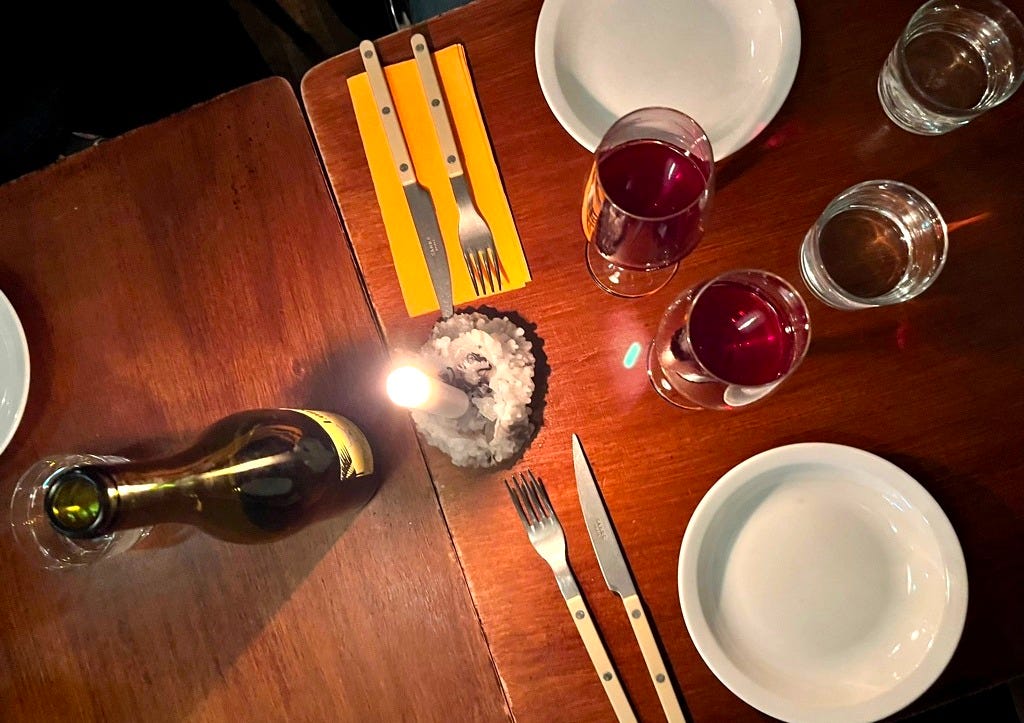French Lessons: How Moving to France Broke My Overeating Cycle
Recipe: French Ratatouille Galette, a household fav!
*This newsletter is not intended to be medical advice. Supported by Mandy Murphy Carroll, RD MPH, Dr. Rosa Keller, PHD RD, Dr. Ricki Pollycove OBGYN, & Dr. Claire Packer OBGYN
Welcome to Modern Women’s Nutrition!
Empowering the busy modern woman to understand her hormone & metabolic health, and how to eat to thrive at every step of her journey—from fertility to menopause and beyond.
NEW!!! Listen to this newsletter as a podcast.
Perfect for your next walk, run or drive!
→ Jump to Recipe: French Ratatouille Galette
Hey gals,
For as long as I can remember, I’ve been afraid of running out of food. (I can hear my mom giggling at this in the distance.)
I’d stash snacks like a bag of nuts in my backpack like a squirrel hoarding for winter, even when I knew I’d eat again in a few hours. I was always thinking ahead to the next meal, worried I might get hungry and not have something on hand.
Have you ever felt this way?
But it wasn’t really about hunger. It was about a kind of panic I didn’t fully understand until I moved to France, where, voilà, everything I knew about eating magically transformed. But of course, it didn’t happen overnight.
One of the first moments I became aware of this shift was while dining at Cheri Bibi, my favorite little restaurant tucked away on a side street in Biarritz. Plates were brought out slowly, one at a time, and were meant to be shared. Diners lingered, chatted, and savored each dish. Nobody was racing to finish their food. Nobody ordered too much out of habit, and thanks to this they finished their plate slowly and contently. And the part that blew my husband and I away?
The servers actually discouraged you from ordering too much. (It’s true!)



In France, if you try to order too much, the server will gently, or sometimes firmly, nudge you to pare it down. We took offense to Olivier’s insistence in the beginning, but now adore him and realize that this is truly just the culture. Not because they’re being stingy, but because they want you to enjoy the meal, to feel satisfied, not stuffed and uncomfortable.
As an American, this was totally foreign to me. I’m not saying that all Americans stuff themselves for every meal. But when it comes to dining and feeling gourmet, I was used to giant plates, ordering way too much, and walking away from meals uncomfortably full—because that’s just part of the dining experience. That’s what we consider as deluxe, a gourmet restaurant evening.
But here, I watched as everyone around me took slow, intentional bites. They seemed okay with the silence that happens when you take in the flavors and textures of a forkful; they seemed to possess the secret to feeling content without feeling stuffed.
Inspired by my French companions, I gave it a shot, slowing down and experimenting with a less is more attitude.
And for the first time in my life, I felt what it was like to be satisfied without overdoing it.
From this French vantage point, I could now see that in the U.S. for most of my life, I was stuck on the hamster wheel of eating. And I didn’t know how to break it.
Perhaps you’re familiar with the cycle: overeat at dinner, wake up feeling heavy and guilty, work out like crazy to make up for it, eat light—a salad of course—to compensate during the day, binge again at dinner because you’re starving. Rinse and repeat.
This harmful way of relating to food starts young.
I think back to high school, when I would wake up at 5:30 a.m. for band practice. Even though I wasn’t hungry, I’d force down breakfast, because what if I didn’t get to eat again until much later? And I’d be starving!
It wasn’t about hunger. It was about some kind of perceived scarcity, of fear, really. Fear of missing out on food, of being hungry later, of not having enough. This wasn’t rational, of course. I’m fortunate to have always known that another meal was there when I wanted it. But I needed to learn that sometimes it’s ok to feel a little hungry.
In college, this pattern got worse. I was terrified of gaining the Freshman 40. So I’d barely eat breakfast or lunch, trying to control my intake. But by dinner, I was ravenous. I’d eat my portion, then finish off my friends' leftovers. I became known as the “big eater” but really I was just snagged in a secret cycle of restriction and bingeing.
At this time I was also using exercise not as a path to feeling good in my body, but as a way to erase what I ate. That relationship with exercise eventually turned movement into punishment.
Here’s what I’ve now learned about the connection between food and exercise, and what I practice daily. Merci, la France!
Working out is not a transaction. It’s not about paying for what you ate. It’s about feeling healthy, alive, and strong.
When you eat to the point of discomfort and try to fix it with exercise, you stay stuck on that hamster wheel.
Moving your body should feel like a gift, not a debt.
Since moving to France, I still love moving my body, but now I do it because it feels good in my muscles and lungs, not because I need to undo last night’s dinner. And I’m learning how to be okay with rest days (slowly)!
The beauty of changing your environment is that it can shift your habits, without even trying.
When I moved from California to France, I discovered that people here don’t eat like they’ll never see food again. Meals are smaller. Glasses of wine are smaller (they consider a bottle to offer 6 servings, where Americans consider it to be 4-5). People savor every bite and sip. And it works. You leave a meal feeling satisfied and energized, not weighed down and sleepy.
There’s a kind of trust that develops when you sink into the knowing that another meal is coming and it will be nourishing, delicious, and shared with care.
I remember the first time I felt that trust in myself. I was out to dinner in France, realizing I hadn’t ordered as much as I normally would back home. And when the plates were cleared, I wasn’t anxiously scanning for dessert or wondering what I could devour next. I was satisfied. Content. Complete.
And I welcomed a few bites of dessert, but simply for pleasure. Because the French rarely skip dessert. ;)
Here are three French lessons about eating I wish I had understood sooner:
You don’t need to have a large, full plate of food to enjoy a meal.
Every bite counts. Slow down and savor.
Food is about nourishment and joy, not something you need to stockpile just in case. (One of my favorite French phrases we often hear at a restaurant is “on voudrait vous faire plaisir” – we want to make you happy.)
How to Eat Like the French (without flying to France!)
You don’t need a passport to learn how to create a balanced relationship with food and exercise. Below you’ll find the French-inspired practices that have completely transformed the way I eat. I use these simple shifts every day, with my family and friends in France, and when I’m back in the States as well.
Keep reading with a 7-day free trial
Subscribe to Modern Women's Nutrition to keep reading this post and get 7 days of free access to the full post archives.







